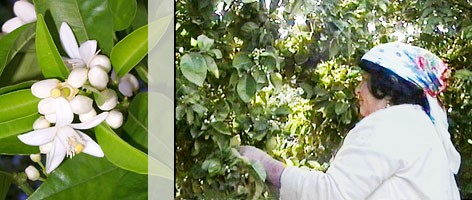
Tunisian Neroli Essential Oil
Neroli essential oil is extracted from the fragrant blossoms of the bitter orange tree (Citrus aurantium subsp. amara), and has a beautiful aroma that appeals to men and women alike. In common with rose and jasmine, neroli oil is a complete fragrance in itself and forms the heart of one of the worlds most enduring perfumes, ‘Eau de Cologne’.
Although neroli essential oil is produced in many countries such as Algeria, Egypt, France, Haiti, Italy, Morocco and Spain, the oils produced in France and Tunisia have always been considered to be the very finest and continue to command the highest price. At Quinessence, our preference is for Tunisian neroli oil.
Unlike most of the trees grown in France, the Tunisian bitter orange trees are usually not subjected to agrochemicals, simply because they are too expensive for the smaller co-operative farmers to afford. Surprisingly, much of the neroli essential oil exported from Tunisia is produced from the blossoms of trees cultivated by small growing co-operatives and families, rather than on larger-scale cultivation farms.
Origins and folklore
It is believed that C. aurantium originated in South-East Asia, later spreading to North-Eastern India, Burma and China, and eventually finding its way via Arab traders to Africa, Arabia and Syria. From these regions it was taken to the Mediterranean by the Moors, and by the end of the 12th century it was cultivated in Seville, Spain, thereby leading to the common name for bitter oranges.
It is not known precisely when or where neroli essential oil was first extracted by steam distillation, but legend has it that during the 17th century in Italy, Anne Marie de la Trémoille (Orsini), who was duchess of Bracciano and princess of Nerola, first introduced neroli oil as a fashionable fragrance to high society. She used it whilst bathing and also to perfume her stationary, scarves and most famously, her gloves.
The fragrance obviously caught on, because in 1709, the Italian perfumer J.M. Farina launched his blend of neroli, bergamot, lavender, lemon, petitgrain and rosemary onto an unsuspecting world, naming it ‘Eau de Cologne’. The rest as they say, is history.
Fragrant assets
The bitter orange tree is a small evergreen that typically reaches a height of 3 metres (10ft) in cultivation, but may attain up to 6 metres (20ft) when growing in the wild. It has a smooth brown trunk, stout branches and flexible green twigs with rather blunt thorns, and has a more erect stature and compact crown than that of the sweet orange tree (Citrus sinensis).
The green twigs contain a significant amount of essential oil, and these along with the broad, ovate, glossy and highly aromatic leaves are used to produce petitgrain oil. The golden-yellow sour fruits are round or oval with a thick, heavily pitted skin that yield bitter orange essential oil by cold expression. This is a truly fragrant tree!
Critical timing
Throughout April and May in Tunisia, prolific clusters of attractive, highly scented blossoms consisting of 5 petals and 24 yellow stamens begin to appear on the tree. Further to the beautiful oil within, these flowers also produce tasty nectar which proves irresistible to honey bees. The oil content of the flowers increases as they develop and bloom.
The flowering buds are usually harvested by hand early in the morning just as they begin to open - but only on warm, sunny days, because damp or overcast weather can have an adverse effect on the fragrance of the oil. It is absolutely critical that the buds are collected at the correct stage of maturity, because if they are plucked too soon the yield of oil will be lower and the resulting oil will have an unwanted 'green' note in the fragrance.
Conversely, if the buds have opened too far when they are gathered much of the precious volatile oil will evaporate during the process of transportation to the stills. Getting the timing wrong either way will have a severe detrimental effect on both the fragrance and value of the distilled essential oil.
Preparation and extraction
Before transportation to the distillery, the collected buds must be carefully 'winnowed' by hand to remove all traces of stray leaves, twigs or similar plant debris. Failure to remove this unwanted material will again result in a tainted fragrance of sub-standard quality, and the producers will be unable to command the high price normally associated with Tunisian neroli essential oil.
Isolation of neroli essential oil is achieved by low-pressure ‘cool’ water-steam distillation which yields a pale yellow oil with an exquisite, fresh, fruity-floral aroma. Up to 20% of the essential oil is dissolved into the water during the process of distillation, and this is recovered by solvent extraction resulting in what is known as ‘orange flower water absolute’.
Since this material consists mainly of the water-soluble components of neroli oil, the aroma is not very representative of the flower, but nontheless is still put to good use in the perfumery industry. Solvent extraction of the flowers produces a dark orange/brown viscous absolute with the most beautiful rich, warm and floral fragrance that closely resembles that of the blossoms. This extract is known as orange flower absolute.
Perfect for skin
Appealing in aroma to both men and women, neroli essential oil is one of nature’s most effective natural antidepressants, which together with its balancing and sedative properties makes it perfect for treating all types of negative emotional conditions, states of anxiety, menopause, and insomnia. This action may also in part explain the reputation of neroli essential oil as an effective aphrodisiac.
Most problem skin conditions respond extremely well to treatments incorporating neroli oil, but for the best results mix it with a hypoallergenic carrier lotion or base cream rather than a carrier oil. Used as part of a regular skin care routine, neroli improves elasticity, stimulates new cell growth, reduces thread veins, softens wrinkles and scars, and smells absolutely divine. The perfect skin care oil!
Copyright © Quinessence Aromatherapy Ltd 2002. Written by Geoff Lyth
If you enjoyed this article, please click the 'Like' button and help spread the word:
Next Yuzu Oil


